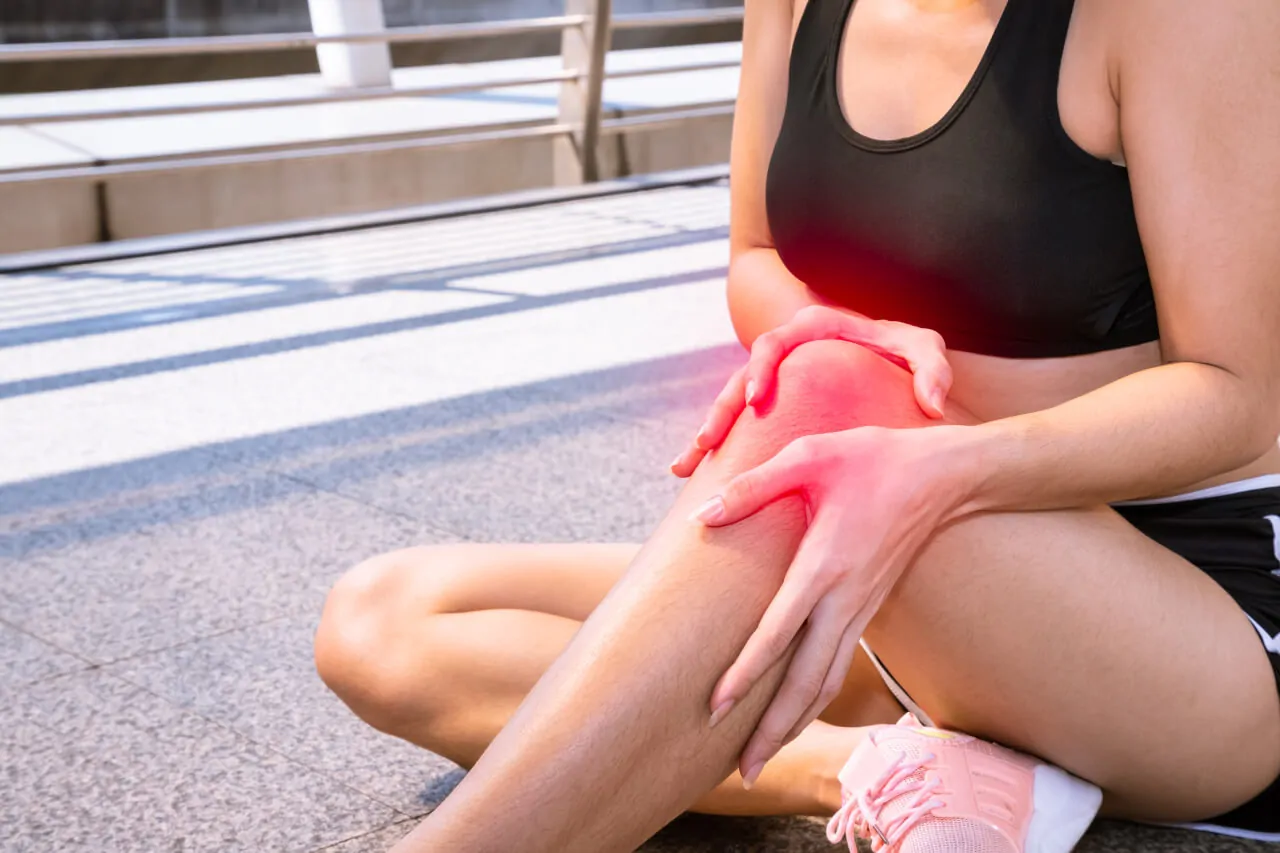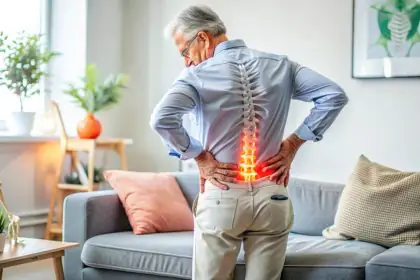In an era dominated by desk jobs, Netflix marathons, and prolonged commutes, the act of sitting has become an integral part of our daily lives.
While the convenience of modern living often revolves around the comfort of our seats, what if we told you that this seemingly harmless activity could be silently wreaking havoc on one of the most crucial joints in your body?
Welcome to the alarming reality of the impact of prolonged sitting on your knees.
The human body is a marvel of engineering, yet its vulnerability to the adverse effects of sedentary behavior is often underestimated.
In this article, we’ll explore the seven shocking ways in which sitting can be a silent culprit, gradually taking a toll on the health of your knees.
As we delve into the startling details of these seven ways sitting can compromise your knee health, it becomes evident that the consequences of a sedentary lifestyle extend far beyond mere discomfort.
Prolonged and improper sitting can contribute to various health issues, including knee problems.
Here are seven ways sitting can negatively impact your knees:
Poor Posture
Sitting with poor posture can contribute to knee pain through various mechanisms.
Here’s how poor posture may affect the knees:
Misalignment of the Spine
Poor posture often involves slouching or leaning forward, which can result in misalignment of the spine.
When the spine is not properly aligned, it can affect the distribution of weight on the lower body, including the knees.
This misalignment may lead to increased pressure and stress on the knee joints.
Increased Stress on Ligaments and Tendons
Poor posture can alter the normal biomechanics of the body.
When you sit with crossed legs or in a position that doesn’t support the natural alignment of your joints, it can place undue stress on the ligaments and tendons around the knee.
This increased stress may contribute to inflammation and pain.
Poor Weight Distribution
When you slouch or sit with uneven weight distribution, it can cause imbalances in the muscles supporting the knees.
Certain muscles may become overworked, while others may weaken.
This imbalance can affect the stability of the knee joint and contribute to pain and discomfort.
Reduced Blood Flow
Poor posture can also compress blood vessels and nerves in the lower body.
Reduced blood flow to the knees may impact the delivery of oxygen and nutrients to the joint tissues, potentially leading to stiffness and pain.
Joint Compression
Sitting with poor posture, especially for long periods, can compress the knee joints.
The increased pressure on the joint surfaces can contribute to wear and tear over time, potentially leading to conditions like osteoarthritis.
Reduced Blood Circulation
Sitting for extended periods can impede blood circulation, leading to stiffness and reduced flexibility in the knee joints.
Reduced blood circulation can contribute to knee pain through various mechanisms.
Proper blood circulation is essential for delivering oxygen, nutrients, and immune cells to tissues, as well as removing waste products.
When circulation is compromised, it can negatively impact the health of the knee joints in several ways:
Diminished Nutrient Supply
Blood carries essential nutrients, such as oxygen and various micronutrients, to the cells in and around the knee joint.
Reduced blood circulation means fewer nutrients reach these cells, potentially leading to a lack of nourishment and impaired cellular function.
Limited Oxygen Supply
Oxygen is crucial for the survival of cells.
Insufficient blood flow means a decreased supply of oxygen to the knee joint tissues.
This can result in a condition known as hypoxia, which may contribute to inflammation, pain, and tissue damage.
Impaired Waste Removal
Adequate blood flow helps remove metabolic waste products produced by cells.
If circulation is reduced, the clearance of waste products from the knee joint may be compromised.
Accumulation of these waste products can contribute to inflammation and discomfort.
Increased Inflammation
Poor blood circulation can lead to chronic inflammation in the knee joints.
Inflammation is a common factor in various knee conditions, such as arthritis.
Inflammatory processes can cause pain, swelling, and stiffness in the knees.
Delayed Healing
When blood circulation is insufficient, the body’s ability to repair and regenerate damaged tissues is compromised.
This can impede the healing of injuries or damage to the knee joint, prolonging pain and reducing overall joint health.
Weakened Muscles
Sitting for long periods can cause the muscles around the knees to weaken.
Strong muscles provide support to the knee joint and help absorb shock during movement.
Weak muscles may contribute to instability and an increased risk of injury.
Weakened muscles due to prolonged sitting can contribute to knee pain through various mechanisms. Here’s how:
Lack of Support for the Knee Joint
The muscles surrounding the knee joint play a crucial role in providing stability and support.
When these muscles are weak, they are less effective at stabilizing the knee during movement.
This lack of support can lead to increased stress on the joint, potentially causing pain and discomfort.
Imbalance in Muscle Strength
Prolonged sitting can lead to imbalances in muscle strength.
Certain muscles may become overused, while others may weaken due to disuse.
Imbalances can affect the alignment of the knee joint and alter the distribution of forces, contributing to pain and instability.
Reduced Shock Absorption
Strong muscles act as shock absorbers, helping to distribute impact forces evenly throughout the body during activities like walking or running.
Weakened muscles are less effective at absorbing these forces, resulting in increased pressure on the knee joints.
Over time, this can contribute to wear and tear on the joint surfaces.
Impaired Joint Lubrication
Muscles contribute to joint lubrication by promoting synovial fluid circulation.
This fluid helps reduce friction between joint surfaces.
Weak muscles may not effectively promote this circulation, leading to increased friction in the knee joint and potential pain.
Poor Biomechanics
Weakened muscles can alter the biomechanics of movement.
For example, weak muscles in the hips or thighs may lead to abnormal stress on the knee joint during activities like walking or climbing stairs.
Poor biomechanics can contribute to conditions such as patellofemoral pain syndrome or iliotibial band syndrome.
Increased Pressure on Knee Joints
Sitting for prolonged periods, especially in a position where your knees are bent, can increase the pressure on the knee joints.
Sitting for prolonged periods, especially in a position that increases pressure on the knee joints, can contribute to knee pain through various mechanisms.
Here’s how increased pressure on the knee joints due to prolonged sitting may lead to discomfort:
Compression of Joint Structures
Prolonged sitting with the knees in a bent position can compress the joint structures, including the cartilage, menisci, and synovial fluid within the knee joint.
This compression may lead to increased friction between the joint surfaces, potentially causing wear and tear.
Reduced Blood Flow
Increased pressure on the knee joints can compress blood vessels, reducing blood flow to the surrounding tissues.
Inadequate blood flow may result in diminished oxygen and nutrient supply to the joint, contributing to pain and discomfort.
Strain on Ligaments and Tendons
Excessive pressure on the knee joints can strain the ligaments and tendons that support the joint.
This strain may lead to inflammation and pain in the soft tissues surrounding the knee.
Impaired Shock Absorption
The knee joints act as shock absorbers during activities like walking or running.
Prolonged sitting can contribute to weakened muscles, reducing the joint’s ability to absorb shock.
This can result in increased impact on the knee joints during weight-bearing activities, potentially leading to pain.
Increased Risk of Osteoarthritis
Chronic compression and increased pressure on the knee joints may contribute to the development or progression of osteoarthritis.
Osteoarthritis is a degenerative joint condition characterized by the breakdown of cartilage, leading to pain, stiffness, and reduced joint function.
Weight Gain
Sedentary behavior, including excessive sitting, is associated with weight gain. Carrying excess body weight puts additional stress on the knee joints.
Weight gain due to prolonged sitting can contribute to knee pain through various mechanisms.
Here’s how excess body weight, particularly when associated with a sedentary lifestyle, can impact the knees:
Increased Load on the Knee Joints
Excess body weight places an additional load on the knee joints, especially during weight-bearing activities like standing, walking, and climbing stairs.
The knee joints bear the brunt of this increased load, leading to greater stress on the joint surfaces.
Accelerated Joint Degeneration
The additional weight can accelerate the wear and tear of the cartilage within the knee joints.
Cartilage acts as a cushion between the bones, and when it breaks down, it can result in conditions like osteoarthritis.
Osteoarthritis is characterized by joint pain, stiffness, and reduced range of motion.
Inflammation
Adipose tissue, or fat, produces inflammatory substances.
Excess body fat can contribute to chronic low-grade inflammation throughout the body, including the knee joints.
Inflammation can exacerbate existing knee conditions or contribute to the development of new ones.
Altered Biomechanics
Excess weight can lead to changes in gait and posture.
The body may compensate for the added weight by altering the biomechanics of movement, potentially placing increased stress on the knee joints.
These altered biomechanics can contribute to conditions like patellofemoral pain syndrome or iliotibial band syndrome.
Weakened Muscles
Individuals with excess body weight may be more prone to muscle weakness, particularly in the muscles supporting the knee joint.
Weak muscles offer less support to the knee, leading to instability and an increased risk of injury.
Limited Physical Activity
Prolonged sitting often correlates with a sedentary lifestyle, which can contribute to weight gain.
Lack of physical activity can lead to muscle weakness, reduced joint flexibility, and overall poor joint health.
Tightened Hip Flexors
Sitting for long periods can lead to tight hip flexor muscles.
Tight hip flexors can alter the mechanics of your gait and place extra stress on the knee joints, potentially leading to discomfort and pain.
Tightened hip flexors due to prolonged sitting can contribute to knee pain through a series of interconnected factors.
Here’s how tight hip flexors may impact the knees:
Altered Pelvic Position
Prolonged sitting shortens the hip flexor muscles, which can result in an anterior pelvic tilt.
An anterior pelvic tilt changes the alignment of the pelvis, affecting the positioning of the knees.
This altered pelvic position may increase stress on the knee joints and contribute to pain.
Increased Stress on Patellofemoral Joint
Tight hip flexors can cause the pelvis to tilt forward, which, in turn, can increase stress on the patellofemoral joint.
The patellofemoral joint is where the kneecap (patella) articulates with the thigh bone (femur).
Increased stress on this joint can lead to conditions like patellofemoral pain syndrome, characterized by pain around or behind the kneecap.
Impaired Biomechanics during Movement
Tight hip flexors can alter the biomechanics of movement, particularly during activities that involve bending the knees, such as walking or climbing stairs.
These altered biomechanics may result in abnormal stress on the knee joints, contributing to pain and discomfort.
Limited Hip Extension
Tight hip flexors can restrict the range of motion in hip extension.
When walking or running, the hips should extend fully to allow for a natural and efficient gait.
Limited hip extension can lead to compensatory movements and increased stress on the knees.
Weakened Gluteal Muscles
Tight hip flexors are often accompanied by weakened gluteal muscles.
The gluteal muscles play a crucial role in hip extension and stability.
When these muscles are weak, the load is transferred to the knee joints, potentially contributing to pain and instability.
Limited Range of Motion
Limited range of motion due to prolonged sitting can contribute to knee pain through various mechanisms.
When you sit for extended periods, certain muscles and joints can become stiff and less flexible.
Here’s how limited range of motion may affect the knees:
Muscle Imbalances
Prolonged sitting can lead to muscle imbalances, particularly in the muscles surrounding the hips and knees.
Some muscles may become tight and shortened, while others may weaken. Imbalances can alter the biomechanics of movement, potentially leading to increased stress on the knee joints.
Reduced Joint Lubrication
Regular movement is essential for the circulation of synovial fluid within the knee joint.
Synovial fluid acts as a lubricant, reducing friction between joint surfaces.
Limited range of motion can impede the flow of synovial fluid, potentially leading to increased friction and wear on the joint.
Increased Joint Stiffness
Sitting for prolonged periods can contribute to joint stiffness, making it more challenging for the knee joints to move through their full range of motion.
Stiff joints are less adaptable and may be prone to increased stress during movement.
Compromised Gait Patterns
Limited range of motion in the hips and knees can affect the normal gait pattern.
The body may compensate for restricted movement by altering the way you walk, potentially placing additional stress on the knee joints.
Impaired Shock Absorption
Adequate range of motion is crucial for proper shock absorption during activities like walking or running.
Restricted movement may reduce the joint’s ability to absorb shock, leading to increased impact on the knee joints and potential pain.
Tips for managing
Managing knee pain due to prolonged sitting involves a combination of lifestyle modifications, exercises, and self-care practices.
Here are some tips to help alleviate and prevent knee pain associated with prolonged sitting:
Take Regular Breaks
Stand up, stretch, and walk around every 30 minutes to prevent stiffness.
Perform simple knee and leg stretches during breaks to maintain flexibility.
Use Ergonomic Seating
Choose a chair that supports the natural curve of your spine.
Adjust your chair height so that your feet can rest flat on the floor, and your knees are at hip level.
Maintain Good Posture
Sit with your back straight, shoulders relaxed, and feet flat on the floor.
Avoid crossing your legs for extended periods, as it can affect blood circulation and knee alignment.
Dynamic Stretching
Incorporate dynamic stretching exercises to improve flexibility in the hips and knees.
Perform ankle circles, knee raises, and seated leg swings to promote joint mobility.
Strengthening Exercises
Include exercises that target the muscles around the knees, such as quadriceps and hamstrings.
Strengthening these muscles provides better support to the knee joint.
Low-Impact Cardiovascular Exercise
Engage in low-impact exercises like swimming, cycling, or walking to improve overall joint health without placing excessive stress on the knees.
Weight Management
Maintain a healthy weight to reduce the load on the knee joints.
A balanced diet and regular exercise contribute to weight management.
Use Cushions or Supports
If you have to sit for an extended period, use cushions or seat supports to maintain proper posture and reduce pressure on the knees.
Cold or Heat Therapy
Apply ice packs or cold compresses to reduce inflammation and numb pain.
Heat therapy, such as warm compresses, can help relax muscles and improve blood circulation.
Anti-Inflammatory Medications
Non-prescription anti-inflammatory medications, such as ibuprofen, may help manage pain and reduce inflammation. Consult with a healthcare professional before using them regularly.
Massage and Foam Rolling
Gentle massage or foam rolling can help release tension in muscles around the knees.
Focus on the quadriceps, hamstrings, and calves.
Stay Hydrated
Proper hydration supports joint health and can help prevent stiffness.
Consult a Healthcare Professional
If knee pain persists or worsens, consult with a healthcare professional for a proper diagnosis and personalized treatment plan.
Conclusion
The relationship between prolonged sitting and knee pain is multifaceted, encompassing various factors that can contribute to discomfort and potential long-term consequences.
Poor posture, reduced blood circulation, weakened muscles, increased pressure on knee joints, weight gain, and limited range of motion are interconnected elements that underscore the importance of addressing sedentary behaviors for maintaining optimal joint health.
Understanding the impact of sitting on the knees emphasizes the need for proactive measures.
Regular breaks, proper posture, and targeted exercises play pivotal roles in mitigating the adverse effects of prolonged sitting.
Strengthening the muscles surrounding the knee, particularly after periods of inactivity, helps provide essential support to the joint, reducing the risk of pain and injury.
Additionally, incorporating lifestyle changes such as staying hydrated, maintaining a healthy weight, and engaging in low-impact exercises can contribute to overall joint well-being.
Recognizing the signs of discomfort early on and taking proactive steps can be instrumental in preventing the development or progression of knee-related issues associated with prolonged sitting.
Ultimately, a holistic approach that includes a combination of movement, proper ergonomics, and mindful lifestyle choices is key to managing and preventing knee pain caused by prolonged sitting.
While these strategies provide general guidance, individuals experiencing persistent or severe knee pain should seek professional advice for a comprehensive assessment and personalized treatment plan.
Prioritizing joint health in our daily routines is an investment in long-term well-being, promoting mobility, and reducing the risk of chronic knee-related conditions.
FAQs
Can sitting for long periods really cause knee pain?
Yes, prolonged sitting can contribute to knee pain. It affects posture, blood circulation, and muscle strength, leading to increased pressure on the knee joints.
How does poor posture while sitting impact knee health?
Poor posture can misalign the spine, affecting weight distribution on the knees. This misalignment can contribute to joint pain and discomfort over time.
How does increased pressure on knee joints during sitting lead to pain?
Excessive pressure on knee joints, especially in a bent position, can compress joint structures, reducing blood flow and potentially causing pain and inflammation.
What can I do to manage knee pain from prolonged sitting?
Take regular breaks, maintain good posture, do stretching exercises, strengthen knee-supporting muscles, and consider weight management for overall knee health. If pain persists, consult a healthcare professional.





